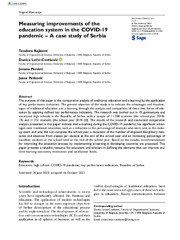Please use this identifier to cite or link to this item:
https://rfos.fon.bg.ac.rs/handle/123456789/2584Full metadata record
| DC Field | Value | Language |
|---|---|---|
| dc.creator | Rajković, Teodora | - |
| dc.creator | Lečić-Cvetković, Danica | - |
| dc.creator | Perović, Jovana | - |
| dc.creator | Petković, Jasna | - |
| dc.date.accessioned | 2023-11-23T07:44:36Z | - |
| dc.date.available | 2023-11-23T07:44:36Z | - |
| dc.date.issued | 2023 | |
| dc.identifier.uri | https://rfos.fon.bg.ac.rs/handle/123456789/2584 | - |
| dc.description.abstract | The purpose of this paper is the comparative analysis of traditional education and e-learning by the application of key performance indicators. The general objective of the study is to indicate the advantages and disadvantages of traditional education and e-learning through the analysis and comparison of these two forms of education by applying defined key performance indicators. The research was carried out in 15 gymnasiums and vocational high schools in the Republic of Serbia, with a sample of 11.204 students (the school year 2018–19) and 11.251 students (the school year 2019–20). The results of the research and conducted comparative analysis presented in this paper indicate that e-learning during the COVID-19 pandemic has significant advantages over traditional education, such as a reduction in the percentage of students who were sent to the make-up exam and who did not complete the school year, a reduction of the number of imposed disciplinary measures and absences from classes per student at the end of the school year and an increasing percentage of excellent students at the school level at the end of the school year. Based on the results, recommendations for improving the education process by implementing e-learning in developing countries are proposed. This paper presents a valuable resource for educators and scholars in defining the elements that can improve student learning outcomes, motivation and satisfaction levels. | sr |
| dc.language.iso | en | sr |
| dc.publisher | SAGE Journals - Information Development | sr |
| dc.rights | openAccess | sr |
| dc.source | https://journals.sagepub.com/eprint/XYSMHPXN8PH7Y2FRQNPN/full | sr |
| dc.subject | Education | sr |
| dc.subject | high school | sr |
| dc.subject | Covid-19 pandemic | sr |
| dc.subject | key performance indicators | sr |
| dc.subject | Republic of Serbia | sr |
| dc.title | Measuring improvements of the education system in the COVID-19 pandemic – A case study of Serbia | sr |
| dc.type | article | sr |
| dc.rights.license | ARR | sr |
| dc.citation.volume | Online first | - |
| dc.identifier.doi | 10.1177/02666669231211533 | - |
| dc.identifier.fulltext | http://prototype2.rcub.bg.ac.rs/bitstream/id/3830/rajkovic-et-al-2023.pdf | |
| dc.type.version | publishedVersion | sr |
| item.cerifentitytype | Publications | - |
| item.fulltext | With Fulltext | - |
| item.grantfulltext | open | - |
| item.openairetype | article | - |
| item.languageiso639-1 | en | - |
| item.openairecristype | http://purl.org/coar/resource_type/c_18cf | - |
| Appears in Collections: | Radovi istraživača / Researchers’ publications | |
Files in This Item:
| File | Description | Size | Format | |
|---|---|---|---|---|
| rajkovic-et-al-2023.pdf | https://journals.sagepub.com/doi/full/10.1177/02666669231211533 | 374.18 kB | Adobe PDF |  View/Open |
Items in DSpace are protected by copyright, with all rights reserved, unless otherwise indicated.
